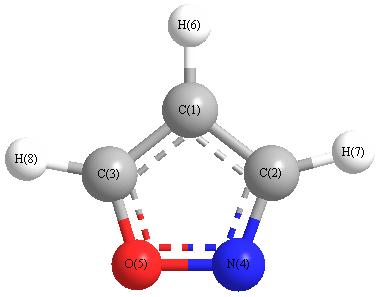Geometric Data

Point Group Cs
Internal coordinates
distances (r) in Å, angles (a) in degrees, dihedrals (d) in degrees
Cartesians
| Atom |
x (Å) |
y (Å) |
z (Å) |
| H1 |
-0.1778 |
2.1863 |
0.0000 |
| C2 |
0.0000 |
1.1262 |
0.0000 |
| H3 |
2.1494 |
0.6954 |
0.0000 |
| C4 |
1.1258 |
0.3703 |
0.0000 |
| O5 |
-1.0939 |
0.3453 |
0.0000 |
| H6 |
1.1568 |
-1.8937 |
0.0000 |
| C7 |
0.6179 |
-0.9612 |
0.0000 |
| N8 |
-0.6914 |
-0.9946 |
0.0000 |
Atom - Atom Distances 
Distances in Å
| |
H1 |
C2 |
H3 |
C4 |
O5 |
H6 |
C7 |
N8 |
| H1 |
|
1.0750 | 2.7638 | 2.2355 | 2.0564 | 4.2927 | 3.2465 | 3.2221 |
| C2 |
1.0750 |
|
2.1921 | 1.3560 | 1.3440 | 3.2338 | 2.1769 | 2.2306 |
| H3 |
2.7638 | 2.1921 |
|
1.0740 | 3.2621 | 2.7728 | 2.2560 | 3.3054 |
| C4 |
2.2355 | 1.3560 | 1.0740 |
|
2.2198 | 2.2642 | 1.4250 | 2.2726 |
| O5 |
2.0564 | 1.3440 | 3.2621 | 2.2198 |
|
3.1746 | 2.1534 | 1.3990 |
| H6 |
4.2927 | 3.2338 | 2.7728 | 2.2642 | 3.1746 |
|
1.0770 | 2.0552 |
| C7 |
3.2465 | 2.1769 | 2.2560 | 1.4250 | 2.1534 | 1.0770 |
|
1.3097 |
| N8 |
3.2221 | 2.2306 | 3.3054 | 2.2726 | 1.3990 | 2.0552 | 1.3097 |
|
Calculated geometries
for C
3H
3NO (Isoxazole).
Experimental Bond Angles (degrees) from cartesians 
| atom1 |
atom2 |
atom3 |
angle |
|
atom1 |
atom2 |
atom3 |
angle |
| H1 |
C2 |
C4 |
133.400 |
|
H1 |
C2 |
C7 |
173.031 |
| H1 |
H3 |
O5 |
38.807 |
|
H1 |
H3 |
N8 |
63.394 |
| C2 |
H1 |
H3 |
47.833 |
|
C2 |
H1 |
H6 |
8.592 |
| C2 |
C4 |
O5 |
34.524 |
|
H3 |
H1 |
H6 |
39.241 |
| H3 |
O5 |
C4 |
5.516 |
|
C4 |
C2 |
C7 |
39.631 |
| O5 |
H3 |
N8 |
24.587 |
Bond descriptions
Examples: C-C single bond, C=C, double bond, C#C triple bond, C:C aromatic bond
| Bond Type |
Count |
| H-C |
3 |
| C-O |
1 |
| N-O |
1 |
| C=N |
1 |
| C-C |
1 |
| C=C |
1 |
Connectivity
| Atom 1 |
Atom 2 |
| C1 |
C2 |
| C1 |
C3 |
| C1 |
H6 |
| C2 |
N4 |
| C2 |
H7 |
| C3 |
O5 |
| C3 |
H8 |
| N4 |
O5 |










